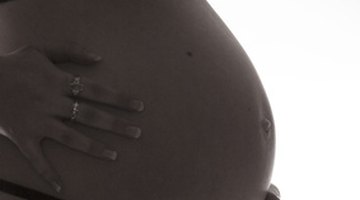When Does The Baby Drop?
How Your Baby Gets Low in Preparation for Childbirth
Your baby happily bounces around in your uterus throughout pregnancy. All those early flutters and later kickboxing sessions in your mid-section are proof. But eventually, most babies settle into a head-down position and drop in preparation for the big day. When does it happen? The answer is different for every mom-to-be.
What Does It Mean to Have Your Baby Drop?

Can a Pregnant Woman Go Into Labor if Her Baby Hasn't Dropped?
Learn More
Lightening is the official term that describes your baby dropping. It's a straightforward milestone in the pregnancy when your baby's head drops lower and becomes engaged in the pelvic area. Lightening marks the beginning of the baby's gradual movement downward as labor approaches.
Doctors use the term "stations" to monitor your baby's head positioning in your pelvis. The scale runs from -5 to +5. If your baby is at a -5, the head is high in the uterus, not yet engaged in the pelvis. At the other end of the scale, a +5 station means that the head is visible.
When Does Lightening Happen?
You can expect your baby to drop sometime during the third trimester, but the exact timing varies from woman to woman. Many first-time moms notice lightening between two and four weeks before baby makes an appearance. Some babies drop earlier. Others wait until the very last minute, only dropping when labor starts. If you've already had a baby, the timing of lightening can be less predictable.
How Do I Know When the Baby Drops?

Signs That Baby Has Dropped In The Pelvis
Learn More
Some women feel definite signs of lightening. The change is particularly noticeable if you carry your baby high naturally, but if junior chooses to hang out down low for the entire pregnancy, the shift may be less noticeable.
How can you tell when your little one starts the downward trek? Some potential signs include:
- Being able to breathe easier due to less pressure on the diaphragm
- Change in appearance of belly with your baby bump looking physically lower
- Pelvic pain or strange feelings in the pelvis
- Increased pelvic pressure
- Increased vaginal discharge
- Less heartburn
- Frequent urination due to pressure on the bladder
Does the Baby Dropping Mean Labor Is Near?
It makes sense to assume dropping means delivery day is near, but that's not necessarily the case. Even though lightening is your body's way of preparing for childbirth, it can still be quite some time before you go into labor.
Since babies drop at different times, it's impossible to say how long you have until labor starts. Some women experience lightening four or more weeks before going into labor, so you may have a few more weeks of nesting before your family expands.
What If the Baby Doesn't Drop Until Birth?
Pregnant-mom worries start at the first glimpse of a positive pregnancy test, but your baby failing to drop before labor shouldn't be one of them. In many women, lightening doesn't happen until right before birth. Your little one may not start the downward descent toward the exit until labor begins.
Your baby dropping isn't an accurate way to predict the start of labor. The experience is different for every woman. Work with your health care provider during the third trimester to monitor your baby's positioning, and don't be afraid to ask if something doesn't feel quite right.











